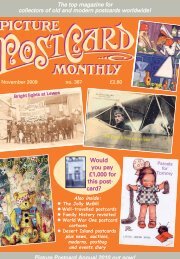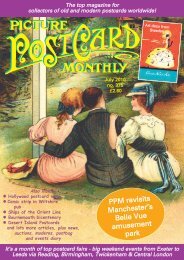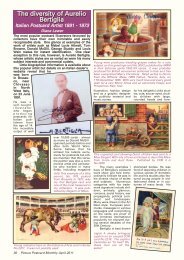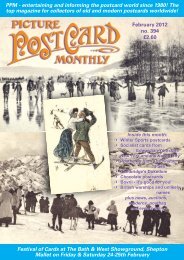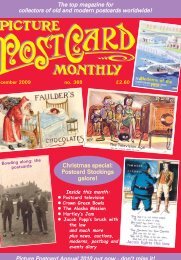You also want an ePaper? Increase the reach of your titles
YUMPU automatically turns print PDFs into web optimized ePapers that Google loves.
making better roads, with<br />
proper drainage, but not<br />
all roads received the best<br />
treatment.<br />
The Leeds & Liverpool<br />
Canal, which took 50<br />
years to build, was opened<br />
over its full length of 127<br />
miles in 1816. The outstanding<br />
feature of the<br />
Huddersfield Narrow<br />
Canal, which connected<br />
Huddersfield with Ashtonunder-Lyne,<br />
was Standedge<br />
Tunnel, 3 miles in<br />
length, where boats were<br />
propelled by<br />
men ‘legging’ against the<br />
roof. At Sowerby Bridge,<br />
the Calder & Hebble Navigation<br />
connected with the<br />
Rochdale Canal to provide<br />
a further route to Lancashire.<br />
The multiplicity of<br />
trans-Pennine rail routes<br />
from the West Riding to<br />
Lancashire consisted of<br />
two from Manchester to<br />
Leeds and two from Man-<br />
chester to Sheffield. The<br />
London & North Western<br />
Railway took its route<br />
from Leeds via Huddersfield,<br />
up the Colne Valley<br />
and through its 3 mile long<br />
Standedge Tunnel, before<br />
descending via Stalybridge.<br />
Slightly earlier, the<br />
Manchester & Leeds Railway<br />
(later the Lancashire<br />
& Yorkshire) completed its<br />
route in 1841. It used the<br />
upper reaches of the<br />
Calder Valley and involved<br />
construc-<br />
Summit Inn was<br />
reached by tramcar on 10 August 1905. The<br />
extension ran close to and parallel with the Rochdale Canal<br />
and Lancashire & Yorkshire Railway. The railway went into<br />
a tunnel ½ mile short of Summit, the nearest station being<br />
at Littleborough. Single-deck car No.1, new in 1902, was<br />
captured on the first day of service or shortly after.<br />
tion of Summit Tunnel,<br />
south of Todmorden and<br />
north of Littleborough.<br />
The Great Central<br />
Railway (formerly Manchester,<br />
Sheffield & Lincolnshire<br />
Railway) route<br />
from Sheffield via Penistone<br />
included the 3 mile<br />
long Woodhead Tunnel.<br />
Although electrified by<br />
1954, the line was closed<br />
to passengers in 1970 and<br />
(left) The Rossendale’ motor bus (name on side) is seen on<br />
Rossendale Road at Crawshawbooth. The former Forest of<br />
Rossendale, edging the Pennines south of Burnley,<br />
remained partly moorland but in part became industrialised.<br />
Tramcars ran along the road shown, but the<br />
omnibus had the freedom to penetrate the hills. Behind<br />
the young men is the workshop of William Hoyle, shoe<br />
and clog maker.<br />
The<br />
tramway extension from<br />
Smallbridge to Littleborough was officially opened on<br />
30 May 1905. The first passenger carrying car, new in 1902<br />
is shown against a background of sturdy Littleborough<br />
properties. Try to spot the differences between this tramcar<br />
No.2 and car No.20.<br />
freight in 1981. The other<br />
route from Sheffield to<br />
Manchester was the Midland<br />
Railway’s Hope Valley<br />
line, some of which<br />
traversed Derbyshire.<br />
Further north, the<br />
Midland Railway network<br />
included a line from Leeds<br />
and Bradford to Skipton<br />
and Clapham, and then<br />
Lancaster and Morecambe.<br />
Bradfordians<br />
made good use of this<br />
when they took holidays in<br />
Morecambe. From Skipton,<br />
a lesser known Midland<br />
spur joined the East<br />
Lancashire Railway at<br />
Colne, thus providing<br />
another trans-Pennine<br />
route.<br />
The period from 1900<br />
to the outbreak of the<br />
Great War in 1914, was a<br />
golden age for electric<br />
trams. Motorbuses came a<br />
little later, although the<br />
halcyon days of their predecessors,<br />
the horsedrawn<br />
wagonettes and<br />
horse buses, coincided<br />
with those of the tramcars<br />
to a large extent. The Pennines<br />
and their western<br />
and eastern slopes engendered<br />
some remarkable<br />
engineering exploits. The<br />
early journeys, such as<br />
‘First tram to Summit’<br />
were a must for photographers<br />
and became the<br />
content of superb realphotographic<br />
postcards.<br />
Some of them accompany<br />
this article.<br />
It was never possible to<br />
cross the Pennines entirely<br />
by tramcar. But as an example<br />
of a journey which must<br />
have been quite remarkable<br />
in 1908, I take the excursion<br />
from Manchester to Halifax<br />
(page 10 of Where to go by<br />
Car). Starting in Manchester<br />
High Street, you boarded a<br />
Manchester Corporation<br />
tramcar to Middleton, fare<br />
3d, and changed to a tram<br />
for Sudden, fare 3d. Three<br />
further changes of cars,<br />
belonging to Rochdale Corporation,<br />
delivered you to<br />
Summit Inn. You then had<br />
to walk 300 yards to catch a<br />
continued....<br />
(above) The last lap of the Where to go by Car jaunt from<br />
Manchester to Halifax began at Hebden Bridge. The Halifax<br />
Corporation car, at the terminus on New Road, is about to<br />
begin a long but picturesque journey to Cow Green, Halifax.<br />
The postcard was published by Crossley Westerman,<br />
photographer, Hebden Bridge.<br />
<strong>Picture</strong> <strong>Postcard</strong> <strong>Monthly</strong> <strong>Jul</strong>y 20<strong>11</strong> 27



